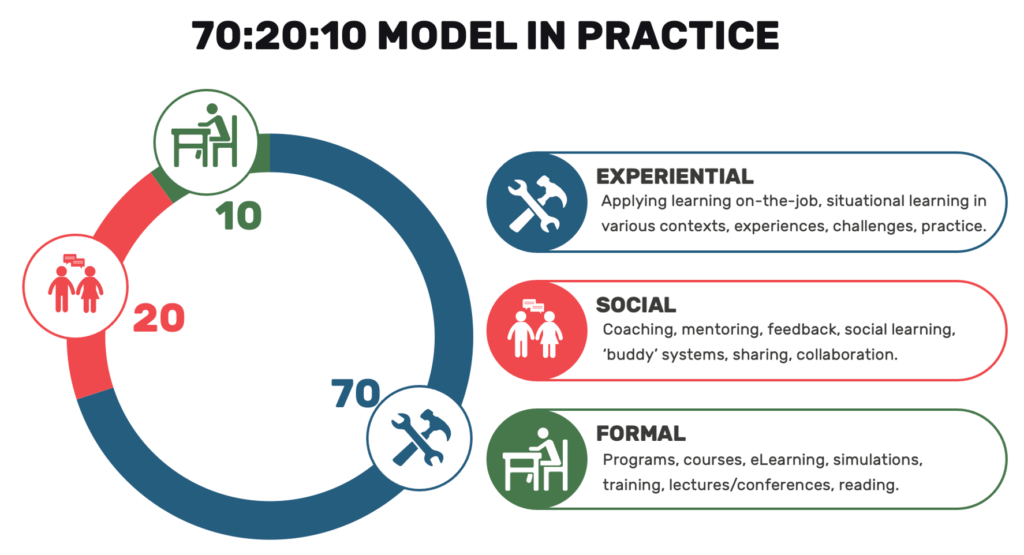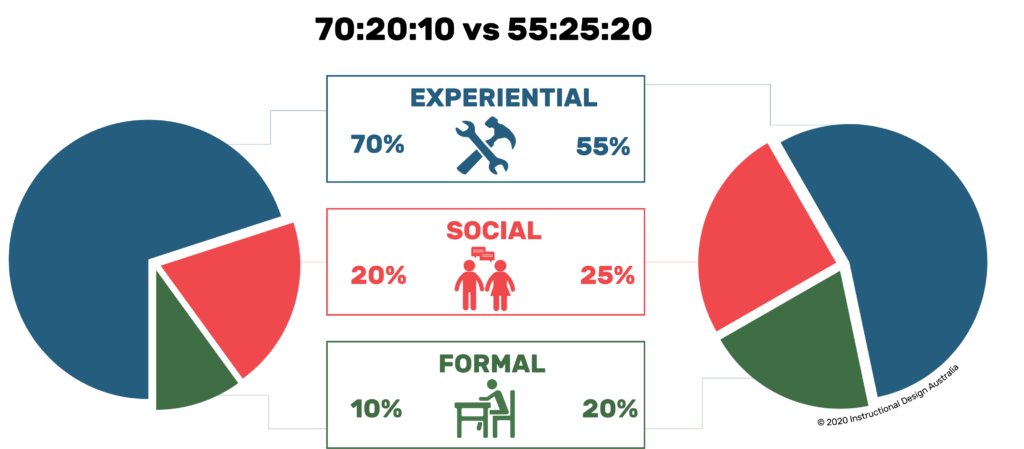The 70:20:10 Learning Model
The 70:20:10 Model is used worldwide as a general guideline for designing effective end-to-end learning programs.
We know that effective learning occurs through experience, exposure and with education [1]. The model has been a ‘change agent’ to shape mindsets and learning practices, moving from traditional ‘chalk and talk’ to blended learning [2].
What does that mean for instructional design?
It can be tempting to focus on formal learning – the learning that occurs during programs and eLearning. [3] Indeed, this ‘10’ from the model is where learners build critical foundations for experiential and social learning [4]. However, apply the 70:20:10 model in learning design means that we must prepare learners for the ‘20’ and ‘70’.
We can prepare learners for on-the-job learning whilst they’re still in the ‘classroom’ – by integrating contextualised knowledge application and skills practice to facilitate learning transfer to the workplace.
Fostering peer relationships will encourage learners to support one another after the formal learning event/s.
Relationships can be cultivated and deepened through experiences that incorporate collaboration, cooperation and teamwork, and provide regular opportunities for shared learning and discussions.
Effective instructional design always considers post-learning opportunities. Formal learning may provide the foundations, but it is through experiences and social interactions that learning is embedded, refined, consolidated and extended.
Experiential Learning
To facilitate experiential learning, Instructional designers can:
- Provide quick reference guides (QRG) for on-the-job reminders of key content, tips, and processes
- Curate a collection of self-paced, practical on-the-job activities and further learning references
- Provide a logbook/checklist of tasks for learners to complete at work
Social Learning
To facilitate social learning:
- Incorporate a ‘buddy system’ – where learners support one another and discuss their experiences in between or post formal learning events
- Schedule virtual ‘check-ins’ or start an online forum/discussion board
- Develop embedding activities for team leaders to facilitate in between or post formal learning events
The 70:20:10 Ratio
70:20:10 is not a fixed ratio [5].
A recent survey conducted by Training Industry found that 55:25:20 is a more accurate split [7].
Regardless of the ratio, the point is: most learning occurs beyond formal training programs, through on-the-job experiences, exposure and social learning.
Formal learning is, however, an essential first step in building a foundation of knowledge, skills and understanding that learners will then expand and refine.
To enable this, instructional designers must consider how programs can best prepare and promote continuous learning.
Related Blogs and Articles
- The Many (Many, Many!) Instructional Design Models
- Embedding Activities in Learning Design: Why Leaders Matter
- Merrill’s Instructional Design Principles
- First Principles of Instruction
- What is Instructional Design
- Understanding Instructional Design
- Do You Need An Instructional Design Degree?
Read more of our blog articles here.
FAQs
What is the 70 20 10 learning approach?
The 70:20:10 Model is used worldwide as a general guideline for designing effective end-to-end learning programs. It proposes 70% of learning occurs through experiences, 20% through social interactions and 10% through formal learning. The model has been a ‘change agent’ to shape mindsets and learning practices, moving from traditional ‘chalk and talk’ to blended learning.
What is the 70:20:10 model called?
The 70:20:10 Model for Learning and Development is a general guideline for designing effective end-to-end learning programs. It recognises that most learning occurs beyond formal training programs, through on-the-job experiences, exposure and social learning.
Who created the 70 20 10 model?
The 70:20:10 model was created by Morgan McCall, Michael M. Lombardo and Robert A. Eichinger, working for the Center for Creative Leadership.
How do you use the 70:20:10 model?
When designing learning solutions, incorporate a combination of experiential, social and formal methodologies:
- Experiential methods include on-the-job training and situational learning
- Social methods include coaching, mentoring, feedback, social learning, buddy systems and collaboration
- Formal methods include eLearning, simulations and lectures
References
[1] WIOA Australia (2019). The Technical Competency Handbook: Knowledge, skills and competency development for water industry operations staff.
[2] Arets, J., Jennings, C., Heijnen V., (2016). 70:20:10 into action. Retrieved form https://702010institute.com/wp-content/uploads/2018/11/Primer-702010-into-action.pdf
[3] [5] 70 20 10 Institute (October 1, 2018). 5 Myths About the 70:20:10 Reference Model. Retrieved from https://702010institute.com/5-myths-702010-reference-model/
[4] Wroten, C., (September 4, 2014). How to Apply the 70:20:10 Model for Learning and Development. Retrieved from https://elearningindustry.com/apply-70-20-10-model-learning-development
[6] [7] Training Industry, Inc. (2018). Deconstructing 70-20-10.
Contact Instructional Design Australia
Instructional Design Australia (IDA) provides instructional design services including the application of the 70 20 10 learning model. With team members in Melbourne, Sydney, Brisbane and Perth IDA will enable your people to engage, learn and perform.
Office
E: info@discoverlearning.com.au
Ph: 1300 528 736
Michael Peart
E: michael@discoverlearning.com.au
Ph: 0434 075 231
Bianca Schimizzi
E: bianca@discoverlearning.com.au
Ph: 0416 013 623



